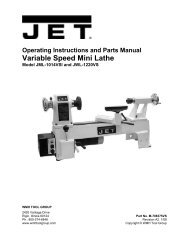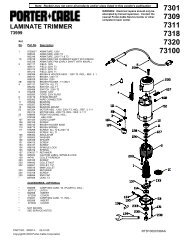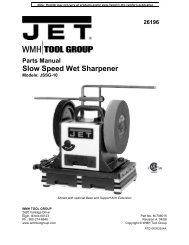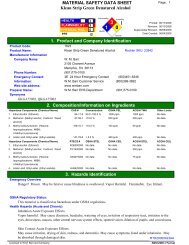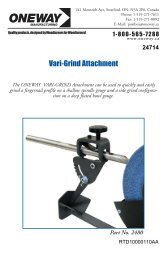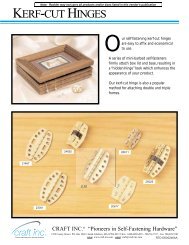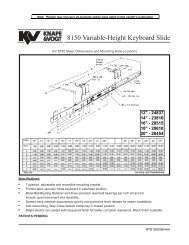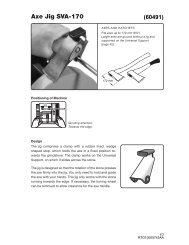dovetail jig supplementary instruction manual (39887) - Rockler.com
dovetail jig supplementary instruction manual (39887) - Rockler.com
dovetail jig supplementary instruction manual (39887) - Rockler.com
Create successful ePaper yourself
Turn your PDF publications into a flip-book with our unique Google optimized e-Paper software.
Step 4 -<br />
Step 5 -<br />
Step 6 -<br />
Step 7 -<br />
Step 8 -<br />
Step 9 -<br />
Step 10 -<br />
Shade the pins that will be removed (Fig. 35C).<br />
Place the pin board back in the <strong>jig</strong>.<br />
Install the half-blind template so that its straight edge faces you.<br />
Adjust the pin board so that the marks align with the straight edge of the templet (D) Fig. 35D.<br />
Make the cuts with the router to remove the shaded pins (Fig. 35E).<br />
Remove all excess material.<br />
If you remove a bit more material than necessary, remember that it will be hidden in the joint (E) Fig. 35F.<br />
E<br />
D<br />
Fig. 35D<br />
Fig. 35E<br />
Fig. 35F<br />
FITTING THE JOINT<br />
Fit the joint the same as you would the half-blind <strong>dovetail</strong>.<br />
SAW KERF ALLOWANCE METHOD<br />
An effective way to match the grain in a decorative box is to make the box from one piece of wood and then cut<br />
the lid with a table saw. However, if the <strong>dovetail</strong>s are evenly spaced, they may be unattractive because the saw kerf<br />
removed needed material.<br />
Fig. 37A<br />
Fig. 37B<br />
NOTE: For this method, you will need a spacer block equal to the thickness of the saw kerf, typically 1/8" on a<br />
standard saw blade. Also, make the boards wider than the final size of the box by the same thickness.<br />
NOTE: This method is very similar to making standard through-<strong>dovetail</strong>s.<br />
22



